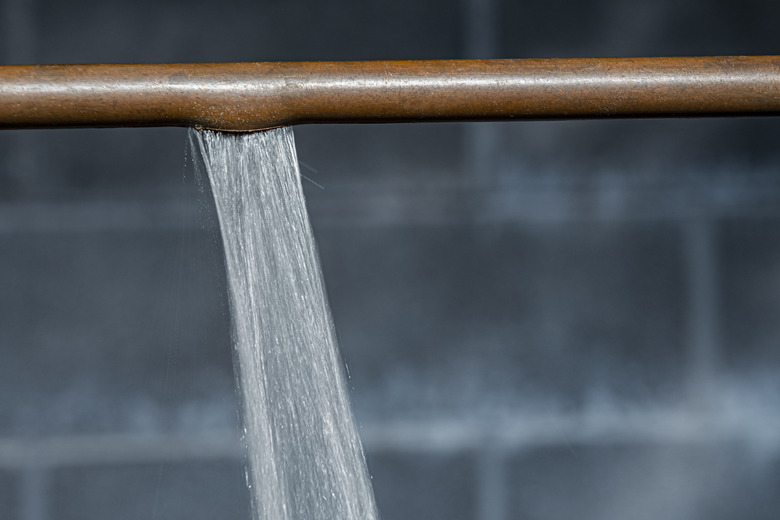How To Tell If You Have A Burst Pipe In Your House
Freezing temperatures can burst pipes, but they aren't the only cause of leaky pipes. Rust, installation issues and physical damage to the pipe can cause a hole to form. Even a trickle of water from a small hole can damage drywall, ruin flooring and cause other damage that can cost you hundreds or thousands of dollars to repair. Identifying the signs of a problem in your pipes can help you stop the leak before it becomes a major issue.
Water Pressure Changes
Water Pressure Changes
A hole in a pipe means less water comes through to your faucets. That can cause a decrease in the water pressure that you notice when you wash your hands, fill your sink or take a shower. Lower water pressure can also increase clogs in your toilet or sinks because the decreased water pressure can't push everything down the pipes. A sudden or unexplained drop in pressure could mean water is leaking somewhere in the system. In the case of frozen pipes, you might notice that no water comes out of the faucet.
Water Marks
Water Marks
Pipes often run through your walls behind the drywall. A leaking pipe behind one of your walls can leave marks or dampness on the drywall. On a multi-story home, pipes running to upstairs bathrooms or laundry rooms can leak down into the ceiling. If you can see the visible signs of water, you already have a good idea of where the leak is located. Depending on the location, you may need to remove the drywall or a portion of the ceiling to get to the damaged pipe.
Standing Water
Standing Water
If the leak is bad enough or goes on for some time, you may notice puddles, drips or gushing water coming out of the area. Follow the source of the water to get a good idea of where the leak is in the pipe. A break in the water main leading into your home can cause a sinkhole or puddles in your yard near the source of the leak. If you notice unexplained water or sinkholes, call a professional right away to investigate.
Water Discoloration and Odors
Water Discoloration and Odors
Discoloration of the water that comes out of your faucets can be a clue that you have a leak or may soon have one. Brownish water sometimes indicates your pipes have rust in them, which often leads to leaks. Water odor can also occur when the pipe leaks. The leak can make it difficult for your plumbing system to push sewage out of your home and into the main line, causing the odor.
Strange Sounds Associated With Water Use
Strange Sounds Associated With Water Use
Broken pipes sometimes cause issues within the plumbing system that cause you to hear unusual sounds. You might notice bubbling and whistling sounds. Bubbling can happen when air gets in the sewer line caused by the leak. Dented pipes that may eventually leak can cause whistling sounds as the water tries to fit through the constricted section. You might also notice a dripping sound within your walls when you run the water if a leak has already happened.
Pipe Issues
Pipe Issues
Exposed pipes, such as those that pass through an unfinished basement or beneath your sink, can show signs of an issue or the potential for bursting. Frost, ice or condensation can let you know that the water inside the pipe is freezing or may freeze soon. Bulges in the pipe often mean the water is already frozen and expanding, which often causes a burst. If the pipe hasn't burst yet, you may be able to thaw the water before any damage happens to prevent issues.
Increased Water Bills
Increased Water Bills
Wondering why your water bills are suddenly higher even though your water usage habits haven't changed? That high bill could be your clue that you have a leak. The water pouring out of the leak adds to your water bill even though you're not actually using it. If you notice your water meter seems to be running constantly even when you're not using water, that can be another indicator of an issue.
Locating the Leak
Locating the Leak
Some burst pipes or leaks are easy to spot. You may be able to trace the source of a puddle or drip. You might see water stains on the drywall. If the damage happens on an exposed pipe, you can see the hole. Other leaks are hidden behind walls and not so obvious.
If you suspect a leak, your first step is to figure out if it's inside your home or outside in the water main. Turn off all appliances that use water, and don't use any faucets, toilets or other sources of water during the test. Look at the water meter. After 30 minutes, check it again to see if it moved at all during that time. If it did, you have a leak.
The next step is figuring out if it's inside or outside the home. Shut off the main water valve coming into the home. Watch your water meter. If it stops moving, your leak is likely inside the house somewhere. If the meter continues moving, the source is likely a water main leak outside the home.
Once you know you have a leak, you can do a little more digging within your home to locate the source. Look for the visible signs of leaks to figure out where the problem lies. Start with obvious spots like toilets, sinks and showers. If you can't find the leak yourself, a plumber can help you find and fix the problem.
